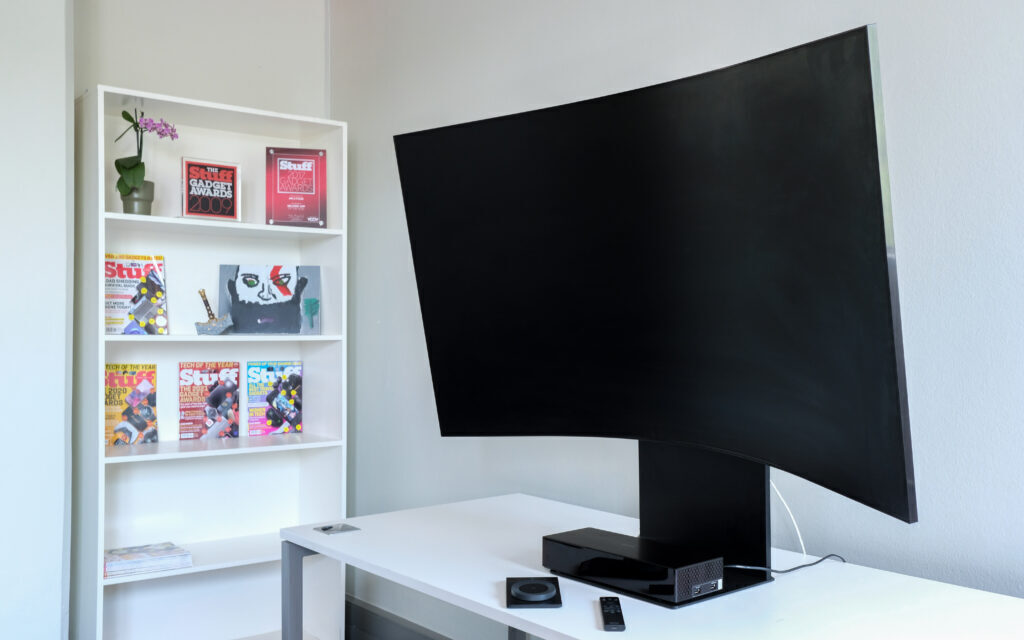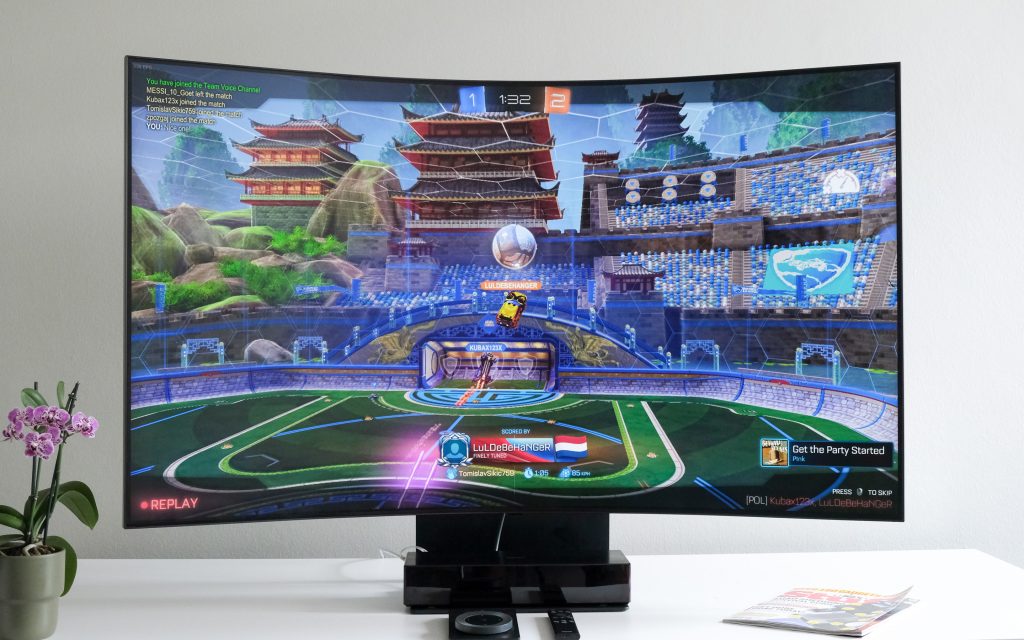While the Samsung Odyssey Ark is mighty impressive on paper, it is simply too much monitor for all but a few use cases. The price is too steep to have to deal with the limitations of the flagship's features and as a result, you end up losing functionality if you replace your multi-monitor setup.
-
Design
-
Display
-
Performance
-
Features
-
Value
It’s been a pretty good year for gaming monitors. We had the first QD-OLED gaming monitor in the Dell Alienware AW3423DW, we saw Sony enter the monitor space with its Inzone range, and now Samsung is trying something new with a big format gaming display (BFGD) that seems like it’s trying to bridge the gap between TVs and gaming monitors.
When the Samsung Odyssey Ark showed up at our office for review, we were excited. That quickly faded when we saw the box. It is gigantic. Was it even going to fit? Well, usually the best way to find out is to just do it. So we did and it fit.
Don’t skip leg day

Or you could wall mount it if you wish. The Odyssey supports a VESA 200 x 200 mount. But then you’ll lose half of what makes this display unique. The height-adjustable stand allows for a decent amount of manoeuvrability, 27cm up and down when in landscape mode, and 3cm when in Cockpit mode (more on that later). There are roughly 10 degrees of tilt in both orientations.
No matter the orientation, you’ll need to be sitting directly in front of the Odyssey Ark to get your money’s worth. The aggressive 1000R curve might mimic the curve of the human eyeball but it also means that if you’re off to the side, even by a little, your content will look washed out. This is the first of many reasons that make the Odyssey Ark ill-suited for use in place of a family TV. Unless you are a family of one.
Let’s get technical
As far as the spec sheet goes, what you’re getting here is impressive. And not just because it’s a bloody great big 55in behemoth. The VA panel also features a 3840 x 2160 (4K) resolution and will manage up to 165Hz refresh rate with AMD Freesync Premium Pro as well as generic Variable Refresh Rate (VRR) for consoles.
This panel uses Samsung’s Quantum Matrix tech and is mini-LED backlit with 1,056 local dimming zones. This makes average-looking games look half-decent and good-looking games pop. You certainly aren’t getting OLED-level inky blacks but colours are still rich enough without being overly saturated.
This couldn’t really be called a gaming monitor without the standard 1ms advertised response time. You’ll no doubt have to switch to the ‘fastest’ setting to come close to this but then you’ll have to put up with some ghosting artefacts because the backlight isn’t keeping up with what’s being displayed. So we’d suggest sticking with the default setting.
As mentioned, this is a mini-LED backlit display so it gets plenty bright enough. Samsung lists peak brightness at 1,000 nits. We didn’t test that but even if the real number doesn’t get there, you probably won’t be disappointed.
We had it set up in our office which is rather bright for most of the day and we didn’t once find the Odyssey Ark lacking. Having said that, it would be best suited in a dark environment. But, if you dim the lights, be prepared to notice some blooming around bright objects in dark scenes.
It’s all connected
The Odyssey Ark makes use of Samsung’s One Connect box to handle all but a few connections. On the display itself, you’ll find the proprietary connection for the One Connect box, a 3.5mm headphone jack, and a USB-C port. Unfortunately, the USB-C port is only there to provide a means of power (15W) to a peripheral device, like a webcam.
On the box, you’ll find four HDMI 2.1 ports with one supporting eARC, an Ethernet 10/100 port, two USB-A 2.0 ports for more peripherals or storage devices, a USB-B port, an optical audio port, and the One Connect port for sending data to the display.
Here’s the next puzzling case of this supposedly being a gaming monitor but not offering basic gaming monitor functionality. There’s no Display Port. Not even one. Sure, you get four 48Gbps HDMI 2.1 ports that will manage a 4K / 165Hz signal from a PC. But then you’ll need to make sure your GPU supports HDMI 2.1. So you’re limited to the RTX 30-series from Nvidia or the RX 6000-series from AMD. Not exactly ideal but if you can afford the Ark that probably won’t be a problem.
Dialling things in
For controlling everything, the Odyssey Ark ships with two remotes, which is one too many in our book. The first will look familiar if you’ve ever used a Samsung TV. The second, the Ark Dial, is unique to the Ark and features a large dial (go figure) with a few directional and settings buttons.
You’ll need to familiarise yourself with the second as that is how you’ll manage the Ark’s many display features. Both come equipped with a solar panel and the TV remote features a USB-C port for charging if you live in parts of the world where sunlight is absent for weeks on end.
With a bit of fiddling, we managed to separate them but we could only do that for advanced remote features, like changing the volume or selecting a source. The power button of any Samsung remote will work for any Samsung Tizen display. This can prove to be really annoying if you work with a bunch of clowns who hose themselves when they switch off both your monitors mid-sentence.
You have been warned.
Are you ready for the “Sound Dome”?
On most of the displays we review, TVs or monitors, that come with integrated speakers, it almost always feels like the speakers were included as an afterthought. We were expecting the same with the Odyssey Ark but in this case, we were pleasantly surprised.
We’ll start by saying you’ll still get much better performance from a separate system, but the four included speakers on the Odyssey Ark offer a surprising amount of oomph. Samsung rates it as a 60W system with a speaker in each of the four corners and two woofers in the centre.
The inherent size of the display, aggressive curve, speaker layout, and inclusion of Dolby Atmos support work well together to create a relatively decent soundstage – the width, depth and height of the projected stereo image. This makes for a rather immersive movie or series-watching experience. But again, you’ll need to be sitting relatively close and straight down the middle for the most enjoyment.
Can your other screen do this?
On to the list of features that sets the Odyssey Ark apart from the rest, for better or worse. One of the angles Samsung is pushing with the Ark is that you can replace your multi-monitor setup.
The large screen size means you can theoretically fit four 27in displays onto a single screen in landscape or three 31in inputs in portrait. Or as Samsung likes to call it – Cockpit Mode. In this orientation, the Odyssey Ark becomes even more of a spectacle. This mode makes for great YouTube Shorts or Instagram Reels viewing.
Next up is something called Flex Move Screen. This allows you to adjust the size of your content and where it sits on the display with the Ark Dial. Don’t feel like craning your neck while playing a first-person shooter? Enable Flex Move and shrink the picture down to a more manageable size and move it to the middle of the screen.
But having a shrunken picture in the middle of your 55in screen might feel like a waste. That’s where Multiview Mode comes in. This gives you a daunting amount of options for splitting the screen up into smaller tiles and you can save up to three custom layout presets.
Picture-in-picture is supported so you can have the YouTube guide for a particularly tough level open while playing a game. Alternatively, you can put the game and the YouTube app side by side so you don’t obscure anything important.
Downhill from here
Unfortunately, as nice as the feature may seem, it is marred by a puzzling amount of limitations that mean it fails to properly meet Samsung’s pitch to “deliver more possibilities on a single screen”.
The big catch here is that, despite having four HDMI ports, you’re only able to view one source at a time, no matter your choice of layout or screen orientation. Where’s the fun in that?
You’re also limited in your choice of apps with which you can multitask. Your choices are one of the four HDMI inputs, YouTube’s app, Samsung’s bare-bones Tizen web browser, mirroring your cellphone or laptop screen, and other less-than-useful Tizen apps like a timer.
And the disappointment doesn’t stop there.
We managed to get a semi-usable layout of a game in the centre, the Tizen web browser displaying the current FIFA fixtures on top and a mirrored laptop with our live Twitter feed below. But then, with Multiview enabled, the maximum refresh rate of the game (Rocket League) dropped to 120Hz, variable refresh rate was disabled, and the image quality dropped noticeably.
These really shouldn’t be limitations you have to work around for the amount of money you’re paying.
Samsung Odyssey Ark verdict
The price of the Odyssey Ark is the biggest limiting factor. For the recommended retail price of R62,000, any reasonable person would expect only the best experience from this undeniably impressive (at least on paper) gaming monitor.
If you approach the Ark from an early-adopter frame of reference, it makes a little more sense. But that also implies Samsung plans to make another one, learning from the downfalls and shortcomings of the first and improving things for a more compelling offer. From what we’ve heard from Samsung South Africa, that may well be the case with the entire first batch of orders selling out rather quickly.
If that is the case, we’d suggest waiting for the Ark 2.0 to avoid being Samsung’s guinea pig. If the company opts not to continue with this product line and focuses on, say, a range of QD-OLED displays, we’d suggest waiting and throwing your (bags of) money at those.
